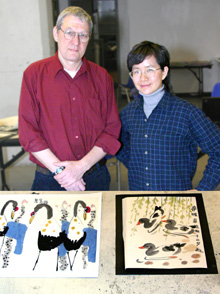Art educators learn from Chinese children's work

Professor David Pariser and visiting scholar Liu Wancen
Photo by Kendra Ballingall
When Concordia Visiting Scholar Liu Wancen travelled from Beijing to Montreal, she packed hundreds of colourful children’s drawings, paintings and prints in her luggage. The pieces represent the diversity of traditional, modern, popular and folk styles currently practiced in regions throughout China.
Choosing two paintings from her collection, Liu points out significant differences in the pieces, painted by two young artists close in age.
The first, by an 11-year old, shows two ducks in a pond painted according to traditional conventions. Ink brushstrokes of varying opacities form the ducks’ bodies, while their beaks and feet are marked by orange paint. The second, painted by a 12-year old, depicts impressions of simplified blue and yellow cranes and outlined lotus flowers on a flat plane. While the subject matter is traditional, the style, composition and colours are unconventional and more modern or “Western.”
“The painting of the cranes emphasizes more personal experience and self-expression, whereas the other is regarded as standardized skills,” says Liu. “But it’s hard to judge the difference in skill levels because of the influence of the teachers and the skills they choose to emphasize.”
As Associate Professor and Vice-director in the Department of Research at the Chinese National Institute of Educational Research in Beijing, Liu’s research interests include cross-cultural art teaching and evaluation criteria. They are interests shared by David Pariser, Concordia Professor in Art Education.
With a background in Education and Developmental Psychology, Pariser, along with professors from the University of BC and McGill, is conducting a study on the teaching of drawing skills in Brazil, Canada and the province of Taiwan, making Concordia an ideal institution for Liu to pursue her research.
Her visit is made possible by financial support from the Office of the Dean of Fine Arts. Duan Lian, Lecturer in the Department of Modern Languages and Linguistics, and Angela Yingwei Fan, MA student at the John Molson School of Business, have provided translation.
While at Concordia, Liu is sitting in on lectures as well as giving her own illustrated presentations. On March 16, she discussed the historical development of children’s art education in China, the current situation, as well as future directions.
“Whereas Chinese art has an ancient history, art education in schools only began in the nineteenth-century,” she explains. “There was a big Western influence on the system. The standard curriculum, for example, includes a portrait-drawing requirement, but in the textbooks the portraits were all of Western figures. Still now, students can only pass university entrance exams with Western-style portraits, not with traditional Chinese drawings.”
Liu’s own interest in art began as a child and developed in later studies, where she learned drawing techniques of lighting, modeling and anatomy by sketching from nature as well as from sculpted plaster busts — standard nineteenth-century European teaching methods.
For Liu, “there should be an emphasis on Chinese art traditions in Chinese art education.” The children’s paintings, however, exemplify the importance of encouraging both local traditions and modernization. She explains that part of the incentive to modernize is pragmatic.
“Traditional drawing, poetry and calligraphy traditions do continue, but companies will not employ students with these skills. Mastering Western drawing skills is very practical because there is a demand in the market. These students can easily find jobs in companies that need designers of products or software.”
From her position at the Central Institute, Liu influences textbook content, scholarship, policy and the national curriculum in China at the primary, secondary and post-secondary levels. One such policy change, in accordance with the Chinese Ministry of Education, will establish classrooms in poorer areas to allow local artists to teach regional techniques and styles.
Liu says, after visiting public school classrooms, she has learned that art educators in Canada teach art appreciation and self-expression, though not necessarily to the exclusion of skill.